TELEVISION ANIME VERSUS MOVIE ANIME
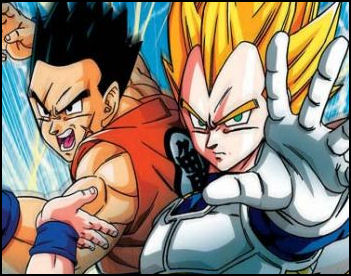
Dragonball TV anime and cinematic anime are very different. On television it's all about presenting the characters in an engaging way within the framework of a limited number of drawings and a limited budget. Kozo Morishita of Toei Animation told the Yomiuri Shimbun: "[We learned that] if you endow the female protagonist with generous breasts, it puts a smile on kids' faces. Also, we turned the limitations associated with static images into a plus by effectively employing very detailed drawings of robots and such like. Working within such constraints let staffers heighten their powers of expression. It may have been a slightly unrefined approach, but in their pursuit of each protagonist's "cool" factor, the staff helped coalesce the traditions of Toei Doga's production methods. [Source: Makoto Fukuda, Yomiuri Shimbun, June 3, 2011]
"TV anime attracts viewers through the accentuation of popular characters, whereas movies can afford to spend a long time concentrating on story composition, development and presenting a world view," Morishita told the Yomiuri Shimbun. "Within these two genres, the director's job is completely different. But when you tackle these roles, you find that it becomes easier both for yourself and for the people who come after you."
Makoto Fukuda wrote in the Yomiuri Shimbun, “Morishita brought the full range of his skills to bear on “Saint Seiya” , which was produced in conjunction with Shueisha Inc. and its publication Weekly Shonen Jump. The project ate up large amounts of time and money: Clouds were drawn with multiple gradations, lavish action scenes were common and staffers poured their hearts and souls into the work.” Morishita recalls, "We used far too much cash, and consequently, I was made a producer so I could learn how to disburse funds appropriately."
In 1978, to deal with a shortfall in personnel, Morishita traveled to South Korea and trained staff there. Five years later, at the invitation of U.S. firm Marvel, he began visiting the United States to help make and direct The Transformers, the success of which brought great benefits for Toei Animation.
Websites and Resources

Oshii's Sky Crawlers Good Websites and Sources: Speed Racer Television Series mahalo.com/stub/speed-racer-tv-show ;Speed Racer Official Movie Site speedracerthemovie.warnerbros.com ; Mobile Suit Gundam animenewsnetwork.com ; Mobile Suit Gundam Official gundamofficial.com ; Official One Piece site onepiece.viz.com Mamoru Oshii on Internet Movie Database imdb.com Satoshi Kon Official Website konstone.s-kon.net ; Paprika sonyclassics.com/paprika ; Full Metal Alchemist fullmetal-alchemist.com ;Tekkon Kinkreet Official Site sonypictures.com/homevideo/tekkonkinkreet ; Appleseed on Anime News Network animenewsnetwork.com ; Evangelion on on Internet Movie Database imdb.com
Links in this Website: MANGA Factsanddetails.com/Japan ; POPULAR TYPES OF MANGA Factsanddetails.com/Japan ; POPULAR MANGA AND FAMOUS MANGA ARTISTS Factsanddetails.com/Japan ; MANGA FANS AND COSPLAY IN JAPAN AND ABROAD Factsanddetails.com/Japan ; OSAMU TEZUKA, MANGA AND ANIME Factsanddetails.com/Japan ; ANIME Factsanddetails.com/Japan ; ANIME FILM AND TELEVISION SHOWS Factsanddetails.com/Japan ; HAYAO MIYAZAKI ANIME Factsanddetails.com/Japan ; MODERN JAPANESE FILM INDUSTRY Factsanddetails.com/Japan ; MODERN JAPANESE FILMMAKERS AND FILMS Factsanddetails.com/Japan ; MEDIA, RADIO, NEWSPAPERS AND TELEVISION IN JAPAN Factsanddetails.com/Japan ; TELEVISION PROGRAMS IN JAPAN Factsanddetails.com/Japan ; CHILDREN’s TELEVISION SHOWS IN JAPAN Factsanddetails.com/Japan ;
Good Anime Websites and Sources: Crunchyroll crunchyroll.com . Crunchyroll is an Internet portal for anime downloads that began as a free fan file-sharing site and grew into a for-profit site that charges users fees that go to the producers of the anime. Free Anime Streams on Watch Anime watchanimeon.com ; Free Anime Streams on Zomganime.com zomganime.com ; Wikipedia article Wikipedia ; Tokyo International Anime Festival tokyoanime.jp ; Anime News Network animenewsnetwork.com ; Anime Books: “Anime: from Akira to Howl’s Moving Castle” by Susan J. Napier (Palgrave, 2001); “The Anime Companion” by Gilles Poitras (Stone Bridge Press, 1999); “Anime Revolution” by Ian Condry, a Harvard professor; “Rough Guide to Anime” by Briton Simon Reynolds.
Articles and Essay on Anime: Essay on Manga and Anime aboutjapan.japansociety.org ; Useful Filmography on Anime aboutjapan.japansociety.org ; Essay on Teaching Anime aboutjapan.japansociety.org ; Essay on Dawn of Anime aboutjapan.japansociety.org ; Anime Blogs Random Curiosity randomc.animeblogger.net ; The Anime Blog theanimeblog.com ; Japan Underground Blog hamblogjapan.blogspot.com ; Anipike anipike.com/ ;
Places That Sell Anime Right Stuf Anime Superstore rightstuf.com ; Anime Corner animecornerstore.com ; Anime Nation animenation.com ; Krazy World of Manga, Anime and Video Games,Japanese, Chinese and Korean CDs and DVDs at Yes Asia yesasia.com ; Japanese, Chinese and Korean CDs and DVDs at Zoom Movie zoommovie.com ; Animax is a satellite channel that specializes in anime. It debuted in 1998 and claims 41 million viewers in Japan and is broadcasts in 46 other countries. Among the classic that are featured are “Dragonball Z”, “Mobile Suit Gundam”, “Astroboy”, and “Lupin III”. Animex is owned by Sony. The Cartoon Network exclusively airs Japanese anime after midnight.
Otaku Urban Dictionary urbandictionary.com ; Danny Choo dannychoo.com ; Otaku Dan Blog otakudan.com ; Otaku Generation Blog generationotaku.net ; Dumb Otaku dumbotaku.com Otaku story in the Washington Post Washington Post ; Otaku History Wikipedia article Wikipedia ; Academic Pieces on the History of Otaku cjas.org ; cjas.org and cjas.org ; Early Piece on Otaku (1990) informatik.hu-berlin.de ; Man, Nation, Machine informatik.hu-berlin.de ; Otaku from Business Perspective nri.co.jp/english ; Otaku Sites The Otaku, Anime and Manga Portal and Blog theotaku.com ; Otaku World, Online Anime and Manga fanzine otakuworld.com ; Otaku Magazine otakumag.co.za ; Otaku News otakunews.com ; Danny Choo dannychoo.com ; Spacious Planet Otaku Blog spaciousplanet.com ; Otaku Activities Maid Cafes stippy.com/japan-culture ; Male Maid Café yesboleh.blogspot.com ; Akihabara Book: “The Best Shops of Akihabara — Guide to Japanese Subculture” by Toshimichi Nozoe is available for ¥1,000 by download at http://www.akibaguidebook.com Akihabara Murders : See Government, Crime, Famous Crimes . Websites: Picture Tokyo picturetokyo.com ; Akihabara News akihabaranews.com ; Akihabara Tour akihabara-tour.com ; Otaku story in Planet Tokyo planettokyo.com
Popular Anime in the 1960s, 70s, 80s
“Astroboy” was the first Japanese animation character to find a large audience outside of Japan. It appeared in the United States in 1963, followed by “Speed Racer” in 1967 and then “Kimba” and “Gigantor”. In the 1970s and 80s, “Battle of the Planets/G-Force” (known as “Science Ninja Team Gatchaman” in Japan), and “Robotech” (source of the Transformers craze) were very popular in the United States.
“Speed Racer” (“Mach Go Go Go” in Japan), “Gatchaman” (“Battle of the Planets”) and “Robotech” were produced by Tatsunoko Productions. The company, formed in Tokyo by two brothers Kenji and Toyoharu, was unique in that it created works that were not based on existing manga. It also produced “Mitsubachi Monogatari Minashigo Hatchi” and “Yatterman”.
Tetsujin 28-go, high-tech humanoid robotknown as Gigantor in English, was was a popular animation series in the 1960s. It was created initially as a manga by the artist Mitsuteru Yokohama (1934-2004), a Kobe native, and later was made into an animated television series and films. In the story the giant robot, under the control of a young boy, fights crime and enemy robots.
A large model if Tetsujin 28-go was erected in2009 in Nagata ward, Kobe, in an effort to attract visitors to the ward, which has never really recovered from the 1995 Kobe earthquake. The statue is 18 meters tall, the same height as the fictional robot. Thirty-eight-centimeter-tall, remote-controlled versions of the robot are sold today for $2,300 by the Osaka-based Sunpac Co.
“Robotech” reached the peak of its popularity in the mid 1980s in the United States. It was comprised of three Japanese series including the “Super-Dimensional Fortress Macross” series. The story was set in the war-ridden Earth of the future and was about the fate of refugees trying to survive.
Other anime watched by American kids included “Battle of the Planets” (“Gatchaman”) and “Star Blazers” (“Space Battleship Yamato” in Japan). Other popular anime in Japan included “Galaxy Express 999", deputing in 1977 and based on a magna by Leiji Matsumoto, and “Bubblegum Crisis” a classic anime from the 1980s.
Europe also embraced anime. “UFO Robo Grendizer” was aired for the first time in 1976 and was a big hit, at one point posting television ratings of 80 percent and creating a big boom in Japanese culture there. It featured a hero named Duke Fleed who operated a giant robot named Grendizer. The series spread across Europe and spawned a genre of animation known as "Giant Robots."
“Akira” (1988) is regarded as one the greatest anime films ever. Described by Time as the “Gone with Wind” of anime, it is an epic about a bunch of kids in post-nuclear future produced by Katsuhiro Otomo. “Akira” developed a cult following in the United States after the film was released.
Anime Films
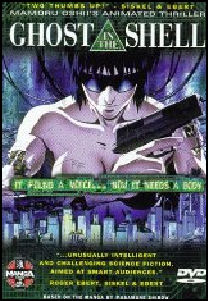
Ghost in the Shell The Japanese animation industry turns out about 30 to 40 feature-length anime films every year. Japanese anime films have only recently starting doing well at the box office with most of the really successful ones are made by Hayao Miyazaki. In 2006, four of the top-10 grossing films were Japanese anime features. See Film
Japanese anime films have traditionally done fairly well on video and DVD and have a large cult following. The sale of anime videos and DVDs is around $500 million a year.
Anime auteurs include Hayao Miyazaki Satoshi Kon, Hideaki Anni, Yoshiaki Kawajiri, Mamoru Oshi and Shinji Aramaki. “The Wings of Honneamise” (1987) is considered the first anime film to be regarded as art. Other highly-regarded anime films include Satoshi Kon's “Perfect Blue” and “Milleneum Actress;”;Yoshiaki Kawajiri's “Ninja Scroll”and” Ghost in the Shell” (1995); and “Neon Genesis Evangelion”.
“For more than two decades the market for standalone animated films has been dominated by director Miyazaki Hayao. Combining humor, social criticism, environmental activism, and poetic lyricism, Miyazaki has produced a string of artistic and box-office successes that includes “Nausicaä of the Valley of the Wind” (1984), “My Neighbor TOTORO” (1988), “The Princess Mononoke” (1997), “Spirited Away” (2001; winner of the 2003 Academy Award for best animated feature film), and “Howl’s Moving Castle” (2004).
“Another important animated film director is Oshii Mamoru, whose two “Ghost in the Shell” movies (1995 and 2004) are groundbreaking science fiction works that question what it means to be human. Both Oshii and Miyazaki released major new animated films in 2008. Oshii's “The Sky Crawlers” is an action and adventure story of young fighter pilots, and Miyazaki's “Ponyo on the Cliff by the Sea” is the tale of a young mermaid who wants to become a human girl.
Hayao Miyazaki See Separate Article
Dai Sato, Koji Yamamura and Mr. Head
Dai Sato is a manga and anime artist who has worked with Radiohead and was involved in the classic “Cowboy Bepod” directed by Shinichiro Watanabe/ And “Ghost in the Shell”. He received an award at the Tokyo Anime Festival for his anime “Eureka Seven”, the story of a teenage boy, a pilot girl named Eureka and a traveling group of mercenaries. He also created “Ergo Proxy”, a post-apocalyptic science fiction about humans and androids living in the domed city of Romdo, “a paradise that doesn’t require emotions” as one promotion put it. Plots revolve around unexplained murders and killer viruses.
Koji Yamamura won an Academy Award nomination in 2003 for “Mt. Head”, a 10-minute animated film based on a traditional Japanese rakugo (comic storytelling) story about a stingy man who end ups having a cherry tree grow out of his head after swallowing a cherry pit. It won other prizes at an Israeli animation festivals.
Yamamura’s “Kafuka Inaka Isha” (“Franz Kafka’s A Country Doctor”) won the top prize at Ottawa 2007 International Animation Festival. Based on a short story by Kafka, it is a short film with surreal-looking characters about a doctor who goes to the home of a dying boy.
La Masion en Petits Cubes and Kunio Kato
“Tsumiki no Ie” (“La Masion en Petits Cubes”) by Kunio Kato won the Academy Award for Best Animated Short Film in 2009. The frames of 12 minute film were painstakingly drawn by hand with pencils and colored in with computers. The frames were drawn on regular A-4 paper and used at a rate of 10 per second with the entire film requiring seven months to produce.
“Tsumiki no Ie” is about a man who lives in a blocklike house and keeps adding bricks to to stay above the rising waters of a flooded world. One day he has to dive into a submerged room to retrieve a pipe he dropped. As he descends, each floor he encounters brings back an old memory. The French names translates to “The House of Small Cubes.”
Kato began independently producing animated films while a student at Tama Art University and worked as ana animator at Robot Communications, He has won many awards for other other works including “Aru Tabibito ni Nikki” (“The Diary of Tortov Riddle”). This and “Tsumiki no Ie” can be seen on You Tube.
Mamoru Oshii
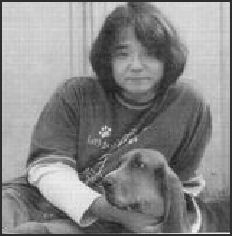
Mamoru Oshii began making independent films when he was in college, He had no plans to make animation films and only got into animation because an animation studio was the only place who get work. He made his first film in 1983, “1: Only You”, based on a popular manga by Rumiko Takahashi. Some of his early films were thrilling and entertaining. Other were criticized for have stunning imagery and unfathomable plots. The release of “Ghost in the Shell” won him international acclaim and on over a global audience
“Ghost in the Shell” (1995) helped bring feature-length anime to an international audience. A film about cyberterrorism in a world in which humans have become cyborgs, the story influenced the Wachowski’s brother’s script for “The Matrix” and influenced other Hollywood films like “The Fifth Element”. “Ghost in the Shell” was directed by Kenji Kamiyama. He also produced “Guardian of the Sacred Spirit”. Steven Spielberg plans to do a live-action adaption of “Ghost in the Shell”.
“Innocence” (2004), the sequel to the “Ghost in the Shell” was the first Japanese animated film to compete for the Palm d’ Or award at the Cannes Festival. The figures are more robotic and the themes more philosophical than “Ghost in the Shell”.
Oshii’s “The sky Crawlers”was released in 2008 and shown at the Venice Film Festival. Based on a story bu Horishi Mori, it is set in the neat future I world dominated by war contractors who employ “killdren” — children who never get old and fight as a way of life — as pilots to do their dirty work. Cristoph Mark wrote in the Daily Yomiuri, “Besides the jaw-dropping realism of his CGI dogfights and lush scenery, Oshii has succeeded is making an interesting film about boredom, apathy and futility.”
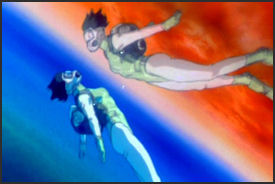
scene from Ghost in the Shell Oshii also made “Avalon”, a live action film set in a video game in which the characters end up as vegetables; and “Assault Girls”, about three women who take on completely different personalities when they become absorbed into the same video game featured in “Avalon”.
Oshii is a big video and computer game fan. He told the Daily Yomiuri, “I’ve got a lot of spare time, so when I start a game like “Dragon Quest”, I don’t stop until I am finished. I don’t go to work. I get a bunch of food ready and eat while I’m playing. In Japanese we call it “taking a trip.” When I “take a trip,” I don’t go to work, I don’t go out. When a phone call comes in, I say, “I’m on a trip.”...But I return to society. The reason I come back is because the game ends. Games have an end, like movies do. But reality is never ending. There’s no choice but to come back to reality.”
Satoshi Kon
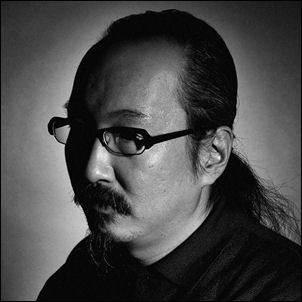
One of Japan’s greatest anime genius’s Satoshi Kon died in August 2010 of pancreatic cancer at the age of 46. "Looking at his overall achievements as a director, writer and artist, Kon was working on the same level as Hayao Miyazaki at his peak," said veteran anime critic Helen McCarthy."If Miyazaki had died at 46, we wouldn't have “My Neighbor Totoro” . At 46, Tezuka hadn't published Black Jack, or MW, or created some of his greatest short films. At 46, Hitchcock hadn't even got as far as Stage Fright. Just think what we might have had from Satoshi Kon at 50, or 60." She praises Kon's capacity to filter a childlike vision and playfulness through sophistication and aesthetic mastery. "For me, the uniqueness of his art is that, as well as the child remaining an artist, the artist remained a child."[Source: Roland Kelts, Daily Yomiuri, September 3, 2010]
"More than almost any other animator in Japan, [Kon] had truly liberated himself from the preconceptions of what anime should be," adds author Frederik L. Schodt, manga authority and translator. "His films are at the top of my list." American animation historian, critic and author Charles Solomon said: "Kon stands out as a creator of unsettling originality. Many directors use flashbacks and dream sequences, but few could match Kon's skill at integrating those elements into the narrative. Kon was one of the most interesting and talented directors working in animation — not just in Japan, but in the world."
Tufts University professor and author Susan J. Napier cites Kon's humanism and empathy as transcendent features in his work, comparing him to postwar giants Akira Kurosawa, Kenzaburo Oe and Miyazaki in his "concern for social issues, the problems of being an outsider, and the ultimate fate of modern Japan."
Satoshi Kon’s Films

Satoshi Kon made four dazzling and unique films: “Perfect Blue” (1997); “Millennium Actress” (2001); and “Tokyo Godfathers” (2003). “Paprika” drew the most attention overseas.
He was at work on his fifth, “The Dream Machine” when he died. “Tokyo Godfathers” received an Oscar nomination in 2003, and Paprika won awards and praise in Europe. [Source: Roland Kelts, Daily Yomiuri, September 3, 2010]
American director Christopher Nolan was accused of plagiarizing ideas from “Paprika” for his Hollywood blockbuster “Inception” . Responding to the accusations on his blog, "Kon's Tone" Kon noted that most artists are influenced by others and identifying examples in his own work, in particular John Ford's 1948 Western, “Three Godfathers” , on which Kon loosely based “Tokyo Godfathers” .
"It may have been fortuitous, but Kon's works tended to be very accessible to Westerners," says Andrew Osmond, author of “Satoshi Kon: The Illusionist” , the only English-language book about the director. "He also educated foreigners about Japan. He told me that when Tokyo Godfathers premiered in New York, he was shocked that people were surprised to learn that Tokyo had a homeless problem. [The Kon-directed TV series] Paranoia Agent shows a Japan terrified of its younger generation, and Millennium Actress telescopes centuries of Japanese history, from the Heian era to World War II and beyond."
Paprika
“Paprika” is an acclaimed anime directed by Kon released in 2006. Based on a story by Yasutaka Tstsui, it about a young girl who exist only in mind of researcher who in turn has developed a gadget called the “DC Mini” that enables him to delve into the minds of his subjects.
David Ansen of Newsweek described it as “one of the most wildly (and disturbingly) inventive animated films I’ve ever seen.” It is “far too unsettling and dense for children (and may prove too challenging for some adults, too).” The film “is part detective story, part thriller, part surrealistic fantasy and a mediation on how we live out our subconscious lives through dreams, Internet and the movies themselves... “Paprika” is so packed with ideas and visual fireworks, it requires more than one viewing. It expands your notion of what animation can achieve. You wake up from it as if from a dream: spooked, provoked and exhilarated.”
The plot of “Paprika” is centered around a machine that allows psychotherapist to enter the minds of patients and alter their dreams. All hell break lose when the machine is stolen. Paprika is the name of the “dream detective” who tries to find out who stole the machine and save the world from running amok.
Makoto Shinkai
Makoto Shinkai is regarded as an anime auteur. His works include “Children who Chase Lost Voices from Deep Below” (2011); “5 Centimeters Per Second” (2007). Atsuko Matsumoto wrote in the Daily Yomiuri: In “Children who Chase Lost Voices from Deep Below” he tries to give the viewer a multicultural experience. The film begins in a mountainous village typical of Japan but the setting is soon transformed into an unknown underworld — visually both stateless and multicultural. The main character, Asuna, is a smart but quiet girl. Instead of hanging around with friends after school, she spends much of her time up in the mountains. With her mother working every day, Asuna is often alone, that is until the day she meets a boy called Shun. The encounters with the mysterious boy and Morisaki, a new teacher at her school, set her on a journey to the mythical underworld. [Source: Atsuko Matsumoto, Daily Yomiuri, April 29, 2011]
To make the story more dynamic, Shinkai created a totally different world for Asuna's journey, a place far removed from the village, which Shinkai modeled after his hometown in Nagano Prefecture. "In animation, like in fantasy games, it's quite common to have European scenery, for no other reason than it's not Japan. But I wanted to create something slightly different from these familiar images," the creator said, adding he took ideas from images of Tibet and the Middle East.”
Shinkai's methodology for his latest film involves blending new imagery to create his visual style. "Animation is drawn by people, and therefore it can only ever be symbolic — a vague image commonly shared by many people. For example a lot of people would think of a red image if they're asked to draw a picture of sunset. But that's not how I want my visual world to be," Shinkai said. To avoid falling into an enumeration of common symbols and codes, the creator says it is important to create realistic looking images. "But I tried to insert my subjective view as an illustrator so it wouldn't appear to be photography," he said. "The observers are always human."
Roland Kelts wrote in the Daily Yomiuri: “5 Centimeters per Second” blends photorealism with painterly effects, lending the frames the vivid surrealism of early morning dream. Shinkai's artwork was captivating, rendering the stark digital glare of a Tokyo station signboard and the soft pastel hues of cherry blossoms with equal intensity.But what impressed me most were his stories: three interrelated short fictions narrating the near-miss romance of two would-be lovers, from tentative childhood affection to adult longing and loneliness. I later learned Shinkai was a literature major in college who was deeply moved by the novels and stories of Haruki Murakami. [Source: Roland Kelts, Daily Yomiuri, February 17, 2012]
Shinkai, 39, cites Evangelion, Hideaki Anno's coming-of-age epic of childhood betrayal at the hands of misguided adults, as having taught him "anime doesn't always have to be about crazy movement and a lot of action. Sometimes it is also about the words or even the lack of words, things not being spoken."
Shinkai has been awarded best director by the Association of Media in Digital (AMD) and has taken the Tokyo International Anime Fair's highest honor, yet he remains relatively unknown beyond dedicated anime circles. His latest feature, Children Who Chase Lost Voices from Deep Below, features an arresting scene with a crouching dinosaur-like creature consuming the two young protagonists in one gulp. It reminded me of Hayao Miyazaki's Princess Mononoke and Nausicaa, wherein fantastical other worlds threaten to overtake our realities.
Shinkai's vision of anime as a public art form, engaged with concerns beyond domestic otaku culture, is encouraging at a time when many in the industry have been churning out lightweight series of little consequence to salvage their bottom lines. "After being alone for so long, I really want to go out and be in the world," he said. "A great way for me to make a commitment to society and participate is to collaborate and create something beautiful."
Full Metal Alchemist
“Fullmetal Alchemist”, created by manga artist Horumi Arakawa, is about a pair of talented young alchemist brothers, Edward and Alphonse Elric, who run into trouble trying to bring back their mother from the dead and lose some limbs in the process. One brother wears robotic prostheses. The other, who lost his entire body, lives on as a soul trapped in a suit of armor. He is the Full Metal Alchemist.
Tom Baker wrote in the Daily Yomiuri, “”Fullmetal Alchemist” is an epic manga series about morally complex characters in an intricately detailed but internally consistent fantasy world. The visuals are beautiful and the storytelling is a deft blend of revelations and teases. It’s nearly perfect.”
The brothers live a world that resembles 19th-century Europe and search for a Philosopher’s Stone that can help them restore their bodies. The aren’t the only ones who want the stone and much of story revolves around the competition to get the stone. The brothers’ rivals include corrupt government officials and supernatural villains based on the seven deadly sin. Their allies include alchemists employed by the dictatorial government.
The series has enjoyed considerable success in Japan and around the world as a manga and a anime television series, directed by is an award-wining director Seiji Mizushima who also did “Evanelion”. In the United States, the television series aired on the Cartoon Network. A movie version of the series — “Fullmetal Alchemist: The Movie: The Conqueror of Shmbala” was released in August 2006.
“Fullmetal Alchemist” (“Hagane no Renkinjutsushi” in Japanese) has large audience and has been acclaimed because its characters are strong and believable; the action is arousing, the alchemy exciting and the artwork is detailed and dramatic with each character having a distinct look. The mangaka Arakawa is not shy about killing off major characters often with traumatic result to readers engrossed in the story. There are comic asides but not much romance. Most of the female characters are soldiers or mechanics.
Many viewers watch “Fullmetal Alchemist” on DVD. It s these 2nd bestselling anime series of all time after Dragon Ball Z. But while Dragon Ball took a decade to develop a following, Fullmetal Alchemist took less than a year. More than 1 million Fullmetal Alchemist books have been published in North America between May 2005 and August 2006. “Fullmetal Alchemist” merchandize is also very hot.
Tekkon Kinkreet
“Tekkon Kinkreet” (2006) is a Japanese anime directed by American expatriate Michael Arias. Based on a popular manga from the mid-1990s by Taiyo Matsumoto, it is about two street children — Black and White — and their run ins with yakuza gangsters in a futuristic Tokyo. The anime — as the manga was — is very violent. The characters are not cute-looking.
Black and White live alone om am abandoned car under an expressway. They are such bad kids even the yakuza fear them. Black is fearless and will fight anyone: the police, aliens, gangsters. White is a playful dreamer who approaches his violent world as if it were a kind of playground.
“Tekkon Kinkreet” won Japan’s Academy Award for Animation and has been well received by the critics. A critic on the NHK show “Anime night Talk” called it a “wonderful movie” that describes “Japanese emotions and atmosphere very well.” An American reviewer called “it an inspiring work of cinema...pure and simple, with no other quaifiers needed.” The manga was created during a period of self-doubt among the Japanese after the collapse of the bubble economy. Loss and destruction are major themes.
The story is set in the futurist Asian city of Treasure Town. Here, Bruce Wallace wrote in the Los Angeles Times, “mechanical Buddhas with elephant heads join gangs, and lost boys battle for turf, while greedy developers from another planet work with the local mob to plow old neighborhoods under. But is the city itself — with 24/7 glow, its temples and “tuk-tuks” and color-splashed skyscrapers with grotesque animal-head motifs — that is the star of this critically acclaimed anime.”
Arais is the first non-Asian to direct a major anime feature. He said of the world is in the film, “The chaos is very Asian: old stuff, new stuff, these ameba-like cities that are constantly consuming themselves.” Also involved in the project were Anthony Weintraub, an American screenwroter, Eiko Tanaka veteran anime producer; and Shinji Kimura, an art diretcor. The film premiered worldwide at the Berlin International Film Festival and premiered in North America at the Museum of Modern Art in New York.
Appleseed and Evangelion
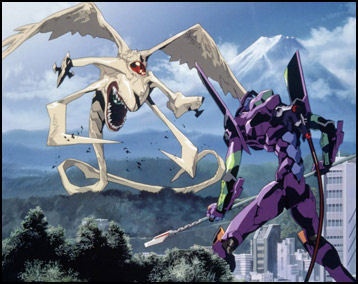
Scene from Evangelion The “Appleseed” film series began with the release of the first Appleseed fim in 2004. It features cyborgs and androids fighting for equal status with humans. Roland Kelts, author “Japanamerica”, wrote in the Daily Yomiuri, that Appleseed series is “visually stunning, ripe with action and hyperkinetic acrobatics...it images combine the characteristic aesthetic of anime with the narrative acting and stunt-riddled energy of a Hollywood blockbuster.”
“Appleseed Saga: Ex Machina” (2008) is a sci-fi anime about a local security apparatus that turns villain by an act of terrorism. Set in 2135, the film is directed bu Shinji Aramaki, produced by John Woo, financed by Toei and features costumes designed by Prada and music from a reunited Yellow Magic Orchestra and Cornelius.
“Evangelion” is a controversial anime created bu Yoshiyuki Sadamoto of the Gainax Studio that began as a television series that ran from October 1995 to March 1996. As a manga series it sold more than 17 million copies and produced films of which “Neon Genesis Evangelion” is the the latest. The story is set in the year 2015, 15 years after a mysterious explosion rocked Antarctica, causing the ice to melt and the seas to rise 60 meters. This is followed by floods volcanic eruptions, economic collapse and ethnic wars, Tokyo is destroyed and replaced by Tokyo-2, which itself is a decoy for Tokyo-3, so it can be safe from attacks from unknown entities called “Angels.”
The main character isn “Evangeleon” is 14-year-old Shinji Ikara, an introverted boy who wants to be left alone, but is forced by his father, head of U.N. paramilitary organization called NERV, to pilot a giant humanoid biomechanical weapon — “Evangelion.” The story follows the constant fighting by Shinji and other 14-year-old boys and girls Evangelion pilots against the Angels. Mysteries that have to be figured out are what made the Antarctic explosion occur and exactly what are the Angels. The tone is pessimistic and the story lacks hope, a reflection of Japan in 1995 after the Kobe earthquake and Aum sarin gas attack when the anime ran on television..
Cyberworld Collides with Reality in '.Hack' Film
Makoto Fukuda wrote in the Yomiuri Shimbun, “Beginning a decade ago, .hack, which features an imaginative online world, has been a popular series in various media including games, anime, manga and novels. The film adaptation is a compilation directed by gamemaker CyberConnect2 Co. President Hiroshi Matsuyama and written by Kazunori Ito--scriptwriter of Mobile Police Patlabor and Ghost in the Shell--who has been involved in the .hack series from the very beginning. [Source: Makoto Fukuda, Yomiuri Shimbun, February 3, 2012]
The film is set in the tourist city of Yanagawa, Fukuoka Prefecture, in the year 2024. Initially, Tokyo was the planned location, but Ito insisted the setting be a more regional city. ".hack always depicts the very near future," Matsuyama said. "The latest film is set 12 years in the future where things have gotten a bit more convenient and people use the Internet more. Instead of having the film's action happen in an urban city, we thought it would be more interesting to have people in a rural town who benefit from digital technology go into a panic." Previous .hack works featured the imaginary game world and reality at a ratio of 9:1. But in this film, reality takes up 60 percent of the film and the cyberworld 40 percent.
The main character, middle school student Sora, feels left out because she doesn't play a popular online game with her classmates. Later, she begins playing on the advice of her friends, and does well. Meanwhile, other people lose consciousness as they play the game. The graphics produced by CyberConnect2's image production team, sai, created the real world scenes in an illustrative, hand-drawn touch. The cyberworld has a more unrealistic feel with distinctive computer graphic images bringing more depth to each scene. "We've studied 3-D animation for a long time and spent a lot of time working on CGI, and I bet our 3-D movie is more comfortable to watch," Matsuyama said.
In conventional anime productions, it's difficult to redo some processes because everything is done by separate divisions--scriptwriting, storyboarding, keyframing, inking and finishing. However, the latest film is made the same way as the games were. The whole picture is finalized first and details are changed from there to improve the film's quality. The CGI work of the film's climax shows the advantage of this process. "Unlike other media, a film can't stop in the middle once moviegoers are in the theater. That's why we paid close attention to the flow and tempo of the movie," Matsuyama said. "The film was made for first-time .hack watchers to enjoy."
Katsuhiro Otomo — 'Akira' Creator
Mangaka Katsuhiro Otomo created Akira. On an exhibition of Otomo’s work, Kanta Ishida wrote in the Daily Yomiuri, “Otomo was involved in the animation of the novel and drawing the comic covers. It may be hard for young fans to imagine that Otomo had the second greatest influence on post-war manga since Osamu Tezuka. [Source: Kanta Ishida, Daily Yomiuri, May 4, 2012]
I've read Akira so many times that I remember every scene, but the original drawings at the exhibition excited me anew. No matter how closely I looked at them, I couldn't believe that they are hand-drawn, as they appear to be made using computer graphics or some other highly sophisticated technique.
Mangaka who are good at drawing details have emerged after Otomo, but Otomo's pioneer spirit will never ever fade away. Otomo stopped drawing manga after finishing Akira and instead devoted himself to anime and live-action films.
In 2005, Otomo released “Steamboy”, an elaborate anime about industrial aggression in the age of steam power in which the forces of creativity and innovation are pitted against the profit-making motive in a world in which steam-driven machine have space-age capabilities, with the story revolving around a British boy named Ray and the discovery of a fuel made from a stable liquid of exceptional purity found in a cave in Iceland.
Other Anime Films
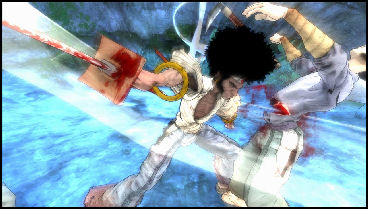
Afro Samurai “Princess Raccoon” by Seijun Suzuki was judged by some to be of the best and happiest film of 2005. “Toki o Kakeru Shojo” (“The Girl Who Leapt Through Time”), based on a story by Yasutaka Tsutsui, was a big hit in 2006. It and “Paprika” were released by the studio Madhouse. “Gunslinger Girl” is an anime about murderous cyborg schoolgirls in plaid miniskirts.
Hip Hop anime include “Samurao Champloo” by Shinichiro Watanabe and “Paranoia Agent” by Satoshi Kon, Champloo is an Okinawan word for stew, Watanane told the New York Times, “I believe samurai in the Edo period and modern hip-hop artists have something in common. Rappers open the way to their future with one microphone; samurai decided their fate with one sword.”
“Afro Samurai” is anime originally shown on the Spike TV channel based on a manga by Japanese artist Takashi Okazaki with voices by actors Samuel L. Jackson, Lucy Lui, Mark Hamill (from Star Wars) and Ron Pearlman. It is produced by Gonzo Digimation Holdings with a soundtrack by RZA, a member of the Wu Tang Clan. Okazaki grew up as a big fan of the American television show “Soul Train” .” The artwork is spectacular to look at. Much of the action is quite gory, with blood dripping limbs and head flying this way and that.
Yasuhiro Yoshiura made the award-winning “Pale Cocoon” (2006) and “Time of Eve” (2008). The latter is about a café where humans and android can hang out together on the condition that no one tries to determine who is human and who is not.
Adult Anime

Adult anime called “hentai” with NOT FOR CHILDREN warnings can be rented at video stores. One particularly revolting release, “Urotsukidoji: Legend of the Overfiend”, features a number of murder-and-rape scenes.
These videos generally sell better in the United States than Japan. Explaining the appeal of these cartoons, one American fan told Newsweek, "You can only take so much of Disney cute, and fuzzy animals. This is about death, sex, love and war."
Some them are quite sexually graphic and the females often have cute, baby faces and incredibly well-endowed bodies. Some are broadcast late at night on regular television.
In March 2006, a man in the United States was jailed for two years for receiving pedophile Japanese anime of girls being forced to have sex with men. He was the first to be prosecuted by a 2003 law about possessing, receiving or distributing obscene cartoons.
Image Sources: YouTube, IMDB, Sense of Cinema, exorsyst blog, Japan Zone, Goods from Japan
Text Sources: New York Times, Washington Post, Los Angeles Times, Daily Yomiuri, Times of London, Japan National Tourist Organization (JNTO), National Geographic, The New Yorker, Time, Newsweek, Reuters, AP, Lonely Planet Guides, Compton’s Encyclopedia and various books and other publications.
Last updated January 2013
